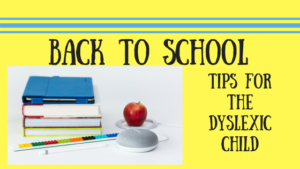
The beginning of a new school year can be exciting. However, what does this mean for the dyslexic child?
If your child is dyslexic or faces any struggles in school, he or she might become quite anxious or overwhelmed at the beginning of a new school year. It may show itself in a variety of forms: sleeplessness, stomachaches, irritability, etc. A parent’s role is to provide the best transition possible when the new year begins. There are several ways parents can “soften the blow” as students return to school.
- Begin following the daily school routine a couple of weeks before school actually begins.
For example, wake your student at the time he/she will be expected to get up on a normal school day. Then have him/her follow the procedures as they would for any school day: get dressed, eat breakfast, brush teeth, gather materials needed for the day, and be ready to go by the appropriate time. (A daily checklist may need to be provided. Some students need to prepare their uniform or clothing and gather school materials the night before.) By allowing dyslexic students to get into their routine ahead of schedule, you are relieving possible stresses and apprehension that these children do not even realize they face.
- Work with your dyslexic child to create an organized workspace designed specifically for them.
Provide all of the possible materials that will be needed in order for your child to be successful when completing homework or studying. (Examples: crayons, colored pencils, sharpened pencils, scissors, paper) They will take pride in their area and find it easier to begin their assignments because they know their location of learning in the home. It may sound trivial, but most dyslexic children have difficulty knowing where or how to begin a task. This workspace provides a consistent location for this to happen.
- Provide assistive technology to aid your dyslexic child with his/her schoolwork.
Audiobooks are often quite animated. Students can listen with earbuds and follow along as the narrator reads. These are available at your local library, Audible.com, BookShare.org, and other places. Additionally, the Chrome Book is a helpful tool with a wide variety of apps to assist dyslexic students. Read Write for Google offers numerous features for children that exhibit characteristics of dyslexia. There is a yearly fee of approximately $100 and educators may create a free account. https://www.texthelp.com/en-us/default.aspx
- Teach your dyslexic child about metacognition.
It sounds tough, but metacognition is simply thinking about thinking. Have your dyslexic child think about the ways (teaching methods) that help them learn best. What are the activities, procedures, graphic organizer, or presentations which have provided them with the most success? If they are not sure, try giving a learning styles inventory. These are available for free on the Internet. Here is just one example: https://www.gadoe.org/Curriculum-Instruction-and-Assessment/Special-Education-Services/Documents/IDEAS 2014 Handouts/LearningStyleInventory.pdf
When your dyslexic child understands his/her learning styles, they can take the presented material and make it work for them. They begin to take ownership of their learning and develop skills that will guide them through their education as well as life.
These tips are just a few ideas that can assist you and your child as a new school year begins.
